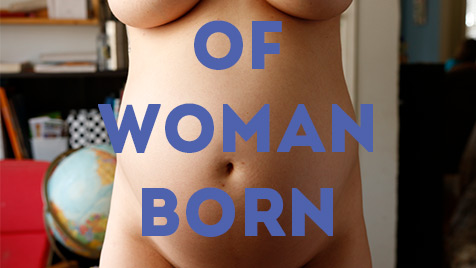Visualizing the sensation of birth through “Of Woman Born””
Recently, I was fortunate to view the current rough cut of filmmaker Scott Kirshenbaum’s latest work, “Of Woman Born,” which is the first documentary told entirely from the perspective of a woman during her labor. The film intimately captures the process of birth as it unfolds for Emily Graham, a mother, wife, and midwife. While other documentaries on birth have faithfully recorded and narrated a wide range of birth stories, Kirshenbaum’s brings the viewer close to feeling the sensations of birth as Emily experiences them. This ability to access the physiology of birth through film on the level of the sensory, as opposed to just the visual, is rare.
Of Woman Born is a treasure for other pregnant women, and particularly for first time mothers who wish to understand some of the physical, psychological, and emotional transformations that a laboring woman might experience. Through poetic descriptions and the movement of her own body, Emily describes her thoughts and feelings of pain and fear, as well as the ideas, visualizations, and imageries that bring solace and strength to her as she journeys towards the birth of her child. The film is similarly endearing for those of us “on the other side,” who have been through birth and remember the journeys we took during our labors. There is a wide variety in the way that women experience birth, and yet there is a lineage that we are all connected to, be it of giving birth or of being born, and Emily taps into that lineage in her own visualization of birth.
The environment in which Emily chooses to give birth is a warm room in her home, and she is surrounded by her husband, midwife, and loved ones. The soothing colors and soft shapes of the room in which Emily labors may also help other women to envision the environment in which they would like to give birth, be it in home or hospital, and how to make that place peaceful, loving, and empowering.
More information and a trailer to Of Woman Born is available through Facebook, SF Film, and Twitter @ofwomanborn.
Scott Kirshenbaum is a Bay Area artist and filmmaker. His first feature length film, You’re Looking At Me Like I Live Here And I Don’t, was a widely viewed documentary on Alzheimer’s, now used as a teaching tool in conferences and universities around the globe. Told from the perspective of one woman living with the disease, the film aired nationally on PBS’ Emmy award-winning program, Independent Lens. ABC World News also featured Kirshenbaum’s speaker series, A Soapbox in Haiti, which premiered in Haiti during the one-year anniversary of the earthquake.

This documentary is now known as “These Are My Hours”
Hi Danielle, yes, you are right and I wrote another post about it in 2018 when it had that name (https://visualizingbirth.org/premiere-in-greece-of-trailblazing-new-birth-documentary-these-are-my-hours). Back in 2017, the working name of the film was “Of Woman Born.” I’m an academic advisor on that film.
Thank you for checking out the Visualizing Birth website!